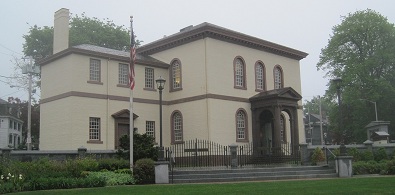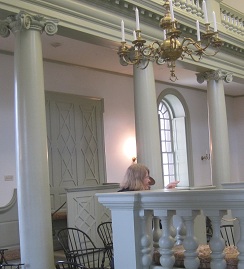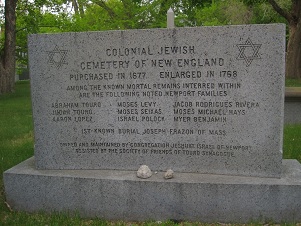I’m on vacation this week in New England. Yesterday I visited the Touro Synagogue in Newport, Rhode Island – the oldest Jewish synagogue in North America, dating back to the colonial era. It was founded by Jews fleeing a long history of persecution in Europe: first the Alhambra Decree expelling them from Spain, then the Inquisition, which harried them from Portugal to the Caribbean. They settled here in Newport and built a synagogue, which survived the Revolution, when most of the city was burned down by the British. But it may be most famous as the congregation to which George Washington wrote his famous “to bigotry no sanction” letter in defense of church-state separation.

The synagogue building, a national historic site, was designed by the colonial architect Peter Harrison.

Inside, there are twelve columns supporting the balconies, each one representing one of the twelve tribes of Israel (notwithstanding the fact that they’re carved in Greek style). The candlesticks and chandeliers are original, donated by some of the first members.

The “president’s bench”, where three U.S. presidents (George Washington, Dwight Eisenhower, and John F. Kennedy) sat when they attended services at the synagogue. Bill Clinton was almost number four.


Up the street is the Touro Cemetery, where some of the founding members, including Moses Seixas, the author of the original letter to Washington, are buried.
As a history buff, I’m glad I got the chance to see it. And I am proud that this country made freedom of conscience one of its founding guarantees, welcoming those whom the rest of the world turned away. But I had a feeling of disquiet at a hypocrisy which nothing in the tour or the visitors’ center acknowledges.
The synagogue was built in Rhode Island, in part, because of its reputation for liberty and religious tolerance, as opposed to many of the other colonies which had officially established state religions and laws that excluded Jews. The congregation is immensely proud of Washington’s letter; to this day, they still hold an annual event where it’s recited.
Yet despite their praise for liberty and tolerance, Touro is an active Orthodox synagogue, which means that its religious services are segregated by gender. Men sit on the first floor, which houses the prayer podium and the ark containing the Torah, while women are consigned to the upper balcony:
Services are held the year around on Friday nights and Saturday mornings and on all Jewish holidays. Services are orthodox using the Nusach Sephard prayerbook. There is separate seating for men and for women during services.
What’s bizarre, according to an article in Haaretz, is that this apartheid arrangement was actually progressive for its time. Prior to the building of the Touro synagogue, women weren’t just segregated, they were kept behind screens that prevented them from even seeing what was going on:
Until the 1760s, women were veritably walled-off in synagogues, hidden behind mehitzot (barriers, in Hebrew) that were either too high to see over, or too opaque to see through (lest the sight of them distract the men praying below).
…Instead of being obscured, the new synagogue’s women’s gallery, which wrapped around the main sanctuary, was built with low balustrades that allowed views of the service below. This was radical at the time, marking a shift in consciousness regarding the place of women in synagogue worship.
But however radical an idea this was in the 1760s, there’s been little or no further progress to speak of in the two hundred and fifty years since then. The continuing segregation is just one example of how, like many patriarchal religions, Judaism has sexist laws that demean and exclude women in ways large and small.
The Haaretz article hopefully concludes that “Women are not immodest distractions. They are equal members of one faith” – but Judaism as a whole is still far from making that idea a reality. Right now, the Newport congregation is in the same place as other believers who value liberty for themselves but still want to preserve their own freedom to discriminate. They’d do well to act on that principle of tolerance they claim to revere, and put it into practice within the walls of their own synagogue.